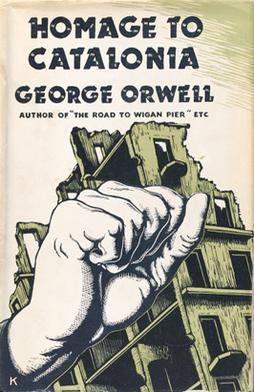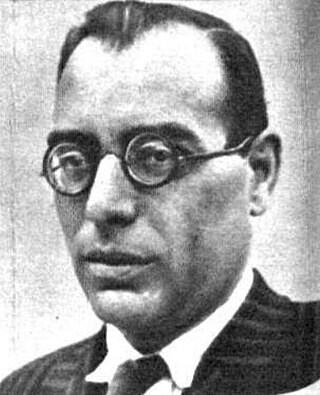
Homage to Catalonia is a 1938 memoir by English writer George Orwell, in which he accounts his personal experiences and observations while fighting in the Spanish Civil War.

The Spanish Revolution was a social revolution that began at the outbreak of the Spanish Civil War in 1936, following the attempted coup to overthrow the Second Spanish Republic and arming of the worker movements and formation of militias to fight the Nationalists. It featured takeover of power at local levels by the Spanish workers' organizations and social movements, seizure and reorganization of economic facilities directed by trade union groups and local committees, and widespread implementation of socialist, more narrowly, libertarian socialist and anarchist organizational principles throughout various portions of the Republican zone, primarily Catalonia, Aragon, Andalusia, and parts of the Valencian Community.

The Workers' Party of Marxist Unification was a Spanish communist party formed during the Second Republic and mainly active around the Spanish Civil War. It was formed by the fusion of the Trotskyist Communist Left of Spain and the Workers and Peasants' Bloc against the will of Leon Trotsky, with whom the former broke.
The May Days, sometimes also called May Events, were a series of clashes between 3 and 8 May 1937 during which factions on the Republican side of the Spanish Civil War engaged one another in street battles in various parts of Catalonia, centered on the city of Barcelona.

Revolutionary Catalonia was the period in which the autonomous region of Catalonia in northeast Spain was controlled or largely influenced by various anarchist, communist, and socialist trade unions, parties, and militias of the Spanish Civil War era. Although the constitutional Catalan institution of self-government, the Generalitat of Catalonia, remained in power and even took control of most of the competences of the Spanish central government in its territory, the trade unions were de facto in command of most of the economy and military forces, which includes the Confederación Nacional del Trabajo which was the dominant labor union at the time and the closely associated Federación Anarquista Ibérica. The Unión General de Trabajadores, the POUM and the Unified Socialist Party of Catalonia were also prominent.
The Friends of Durruti Group was a Spanish anarchist group commonly known for its participation in the May Days. Named after Buenaventura Durruti, it was founded on 15 March 1937 by Jaume Balius i Mir and Félix Martínez, who had become disillusioned with the policies of the CNT-FAI's leadership. During the May Days in Barcelona, they actively agitated among the anti-government forces, advocating for the formation of a "revolutionary junta", in close collaboration with Spanish Trotskyists. Following the suppression of the uprising, the group began publishing the newspaper El Amigo del Pueblo, in which they denounced the CNT-FAI for "collaborationism", resulting in their expulsion from the organisation. Their 1938 pamphlet Towards a Fresh revolution, which reaffirmed their proposals for a revolutionary junta, became an influential text within the anarchist current of platformism. But the group ultimately failed to make a broader impact within the Spanish movement and collapsed by the end of the war.

Clara Thalmann was a Swiss journalist, athlete and militiawoman, who fought during the Spanish Civil War.
Lois Orr, also known as Louise Cusick, Lois Cusick and Lois Culter was a 20th-Century American member of the Workers' Party of Marxist Unification (POUM) female militia.

Joan Comorera i Soler was a Spanish Communist politician, journalist and writer from Catalonia who spent several years in Argentina before returning to Spain in 1931 at the start of the Second Spanish Republic. He was a Catalan nationalist, and was elected chairman of the Socialist Union of Catalonia in 1933. In 1936 he became Secretary General of the Unified Socialist Party of Catalonia (PSUC), in alliance with the Spanish Communist Party. During the Spanish Civil War (1936–1939) he built up his party into a major political force during the struggles among the supporters of the Republic between Socialists, Stalinists, Trotskyists and Anarcho-syndicalists. After the Republicans were defeated by the right-wing forces led by Francisco Franco he went into exile, living in Mexico and then in France. In 1949 he was expelled from the Communist party for his Catalan nationalism, and survived an assassination attempt. In 1951 he moved back to Catalonia using a false name. He was arrested in 1954 and died in prison four years later.

The Madrid Defense Council was an ad-hoc governing body that ran Madrid, Spain, for about six months during the Spanish Civil War (1936–39). It was formed in November 1936 after the Spanish Republican government had fled to Valencia when General Francisco Franco's forces advanced on Madrid. It was expected that the city would fall within a few days, but the arrival of the International Brigades halted the rebel advance, and the situation settled into a stalemate. The council was dominated by communists, who had superior organization and propaganda to the other groups. Their policy was to organize the militias into regular troops and focus on defeating the enemy, rather than to undertake revolutionary activity. As time passed there was growing tension between the communists and more radical groups. The council was dissolved in April 1937 and replaced by a new city council.

Mika Feldman de Etchebéhère was an Argentine militant anarchist and Marxist. She served as captain of the POUM militia during the Spanish Civil War in 1936, and was also active in the anarcha-feminist organization, Mujeres Libres.

Women who were part of the Republican faction in the Spanish Civil War were involved both on the home front and on the battlefield.

Feminists were involved in the Spanish Civil War, although the conditions underlying their involvement pre-dated the Second Republic.

Milicianas fought in the Spanish Civil War. They came from a culture with iconic fighters, and where women had been recently empowered through direct political engagement in political organizations and labor unions. The Dictatorship of Primo de Rivera saw women take more to the streets to protest and riot, though their actions were dismissed by male political leaders. The creation of the Second Spanish Republic led to an environment encouraging active political participation in broader Spanish society, and ultimately served to assist many women in their decision to head to the front, as the Government expanded rights for women, including the right to vote, divorce, go to school and stand for election.
Women in the Federación Anarquista Ibérica were often only addressed because of what they appeared to be able to offer male FAI leadership in terms of attracting adept fighters and politicians.
Women in the Communist Party of Spain were highly active, the most visible figure in the movement being Dolores Ibárruri, who joined in its early years. The Dictatorship of Primo de Rivera pushed the group underground, where they had to meet clandestinely around their public face, the football club Oriente FC.

Women in the Popular Front in the Spanish Civil War were part of a broad leftist coalition founded ahead of the 1936 Spanish general elections. The Second Spanish Republic represented a changing cultural and political landscape in which women's political organizations could flourish for the first time. It failed to empower women completely, as they were often locked out of governance roles and positions in political organizations. Many organizations continued to discriminate against women, as Marxist ideology did not see them as a unique group with special needs but as part of larger class grouping in which class equality needed to be prioritized.

Women in the Spanish Civil War saw the conflict start on 17 July 1936. The war would impact women's everyday lives. Feminist solutions to problems of women in this period often took an individualistic approach. For women of the Second Republic, by close of the Civil War their efforts for liberation would fail.
Women in POUM in Francoist Spain were few as many, along with male dominated leadership, were forced into exile following the end of the Spanish Civil War. Those in exile often felt isolated and alone. Those who remained were sometimes sent to prison. POUM women participated in a hunger strike at Madrid's Las Ventas prison in 1946. The group fell by the wayside as Partido Comunista de España became the pre-dominant resistance organization in Spain. The organization finally dissolved during the 1950s in Toulouse, France with its memory kept alive by the wife of its last president, María Teresa Carbone, through the Fundació Andreu Nin.
Josep Rovira i Canals (1902–1968) was a Catalan politician, a leader of the Workers' Party of Marxist Unification. During the Spanish Civil War he managed to send several militia units to the Aragon front, and was arrested by the republican authorities in the context of the repression against the POUM.











